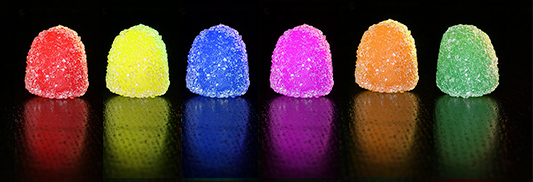To use a silly example (often
the silly examples are the best):
Here are six delicious pieces
of bubble-gum. This is gourmet bubble gum, and so, not only do
they have different colors, but they each have different flavors:
cinnamon, banana, blueberry, "traditional" bubble gum,
etc. Each piece can be distinguished from another, but all share
the excellent properties of bubble-gum.
And here are some gum-drops--gummy
on the inside, and covered with sugar crystals on the outside.
The colors are the same as the bubble gum, but the flavors are
different: Cherry, lemon, peppermint, vanilla, etc.
Would you have any trouble comparing
a red (cinnamon flavored) bubble gum to a yellow (lemon flavored)
gum drop?
Would it be just as easy to compare
a pink ("traditional" flavored) bubble gum to a blue
(peppermint flavored) gum drop?
Of course it would be easy! We
all know the difference between a piece of bubble gum and a gum-drop.
The colors and the flavors are individual differences, but the
basic categories of bubble gum and gum drops are easy for us
to identify.
Going back to art, let's consider
two periods in ancient Greek art, the period from 900-323 BCE,
sometimes called "Hellenic," when Greek culture was
mostly confined to the Greek mainland, and Hellenistic art, produced
from 323 - around 31 BCE, when Greek influence spread around
the Mediterranean. Each period has an easily identifiable style.
Do you see how, if we are considering six Hellenic art works
instead of six flavors of bubble gum, we're using exactly
the same principle?
Suddenly, instead of six unrelated
works of art, you have ONE category--Hellenic art--and six variations,
for each work has its individual properties, or "flavors,"
just as the six pieces of bubble gum are a single category with
different colors and flavors. This is MUCH easier to handle.
If I ask you to compare a work
of Hellenic art with a work of Hellenistic art, it doesn't matter
which works I "throw" at you, because you know the
underlying principles or properties of each category, and are
just comparing examples of two different artistic trends -- just
as if you were comparing "traditional" flavored bubble
gum, which comes in pink balls, to a green, spearmint flavored
gum drop--or a cinnamon-flavored bubble gum to a vanilla flavored
gum-drop.
The details are different, but
the underlying differences between bubble gum and gum drops are
the same.
Once you really grasp this principle,
then after each class meeting you need to process the information
covered in class, and the required readings in the textbook.
Prepare some study notes, so you won't have to go back to the
textbook or the notes you took in class. Start by considering
the big picture. What major trends are discussed? How do individual
works of art or architecture illustrate these trends? How does
the art work reflect the time in which it is made? It won't work
to just read and highlight parts of the textbook: the best method
is to make outlines and / or flashcards for yourself. The very
act of preparing these notes will help you to solidify your understanding.
When you've really thought through
the class materials in this way -- as you go along, and not cramming
just before the test -- you'll be beautifully set up to review
in preparation for the test. And I think you'll find that the
wealth of information is manageable after all.


